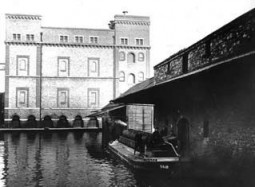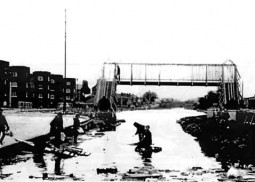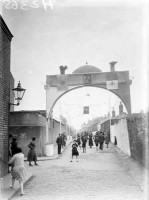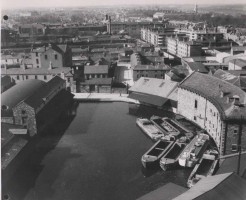A Snippet of Dublin History (Part 8) – Basin Street Harbour

Dublin was the first modern city to produce a public water supply, in the 13th century. The River Poddle provided a source of water for the early settlers of the city. About 1670 the reservoir known as the city basin was established. Because of the construction of earth and stone works to facilitate the water supply, the surrounding area became affectionately known as the “Back of the Pipes”. Between 1682 and 1721 the population of Dublin City almost doubled, from 60,000 to 120,000 people.
To meet the increasing demands, in 1721, a new City Basin was built off James’s Street, capable of supplying 25 million gallons of water, a three month supply, and of supplying water to 90 streets. The corporation raised and reconstructed the level of the Basin, in the final development of the Poddle water supply to the city. By 1735, the Poddle could no longer meet the water needs of the City. As the Grand Canal passed just south of the City Basin, it was decided that water from this source would be passed to the Basin by means of sluice gates.

We have a very interesting account from a tourist named Richard Twiss, touring Ireland in 1775 of the Basin. “The city basin is a reservoir, capable of holding water to supply the city for some weeks, when the springs from whence it is filled are dry; both the springs and the reservoir were dry whilst I was in Dublin. In 1765 a canal was begun to be cut from this place, and intended to be continued to Athlone, which is about 70 English miles off, in order to open a communication with the Shannon; at the rate work is at present carried on it bids fair for being completed in three or four centuries.”
In the 18th century the Basin was a fashionable resort for the citizens, the rich and famous went to take the air there. The approach to the Basin was an ornamental arch at the end of Basin Lane. Coaches and sedans set down ladies and their escorts in the finery of the time. They passed under the arch and saw before them a long stretch of water, with pleasant walks and garden seats and music being played by a band. Concerts and fireworks displays were part of the scene.

We have a description from the History of the City of Dublin Volume 2.
The description of the harbour as occupying nearly five and one quarter English acres and commanding uninterrupted views of richly ornamental country.
” Its distinction as a reservoir to supply an extensive city with water rendered it necessary to give its surface as great an elevation as was consistent with moderate expense; for this purpose it is supported by a firm embankment of earth several feet higher than the adjacent fields, on the summit of which is a walk, bounded on both sides by quick-set hedges, judiciously kept low not to interrupt the view, while the outer fence is planted with elms, still in a good state of preservation, with their branches expanded so as to entwine with each other and form graceful arches; and these, from the moisture of the soil, are clothed in spring and summer with luxuriant verdure, they add much to the beauty of this charming scene. The form of the basin is a parallelogram, 1210 feet in length and 225 to 250 feet in breadth. The entrance is by a neat iron gate from Basin Lane and Pig Town, the latter appropriately so called, from being perpetually infested with those animals, and forming by its filth a strong contrast to the salubrious air and cheerful tranquillity of the scene within.”
Eventually, the supply of water from the canal was inadequate and unsafe and this supply to the City Basin ceased in 1869, paving the way for a new water supply from the Vartry River.
The proximity to the Grand Canal and the Liffey was essential to the growth of the Guinness brewing industry. The use by the brewery of the canal resulted in the survival of the Grand Canal Harbour as a transport hub, into the 20th century. Canal boats bearing barrels of Guinness started their journey through the length of Ireland, from Grand Canal Harbour (incidentally the reason behind the present name of the “Harbour Bar”). However on the 27th of May 1960, a barge loaded a large cargo of Guinness to go to Limerick. Around teatime the barge left James’s Harbour and this would never happen again. It was the last trade boat to leave Dublin.










I lived with my granny in the 50s in Maryland near Basin Lane and it was a wonderful place to grow up. In the winter we could skim stones across it and I often walked across it when there had been a heavy freeze. (I was very lucky not to have went through the ice) In the summer we did not have to go to the beach as we all swam and fished there, the barges were a bit of a nucience as we had to climb out every time they passed up and down. Some times we were cheeky and got a ride up to Rialto bridge where we were thrown off some times getting helped off with a well aimed kick to the back side. Saturday, was like the circus had come to town, from the metal bridge to the canal basin barges would be bumper to bumper as they waited to be unloaded of their cargo’s of sack’s of barley onto 4 wheeled lorries as they were called, others had cargo’s of empty Guinness barrel’s, it was a hive of activity as the men wanted to get home. They used to stand around in groups and as we walked through them, they seemed to be laughing and shouting in a different language, but later I realised it was just their broad country accent,it was a lovely time
Great article.
Went to school in Jamebo in the mid 70s. Sadly the harbour was gone and the canal stopped at the point where it narrowed at St James Walk. It was then subsequently filled in as far as Rialto.
I’ve been reading about the old City Basin (where Jamebo Flats and the girl’s school are/were.
This basin was filled up for a couple of hundred years by a pipe from the Poddle which used to go through Crumlin, Dophins Barn, Rueben Street and down onto St James Walk and into the Basin. Hence the saying “the back of the pipes”. Does anyone know where I could view pictures of this old infrastructure before it was knocked down for Fatima Mansions?